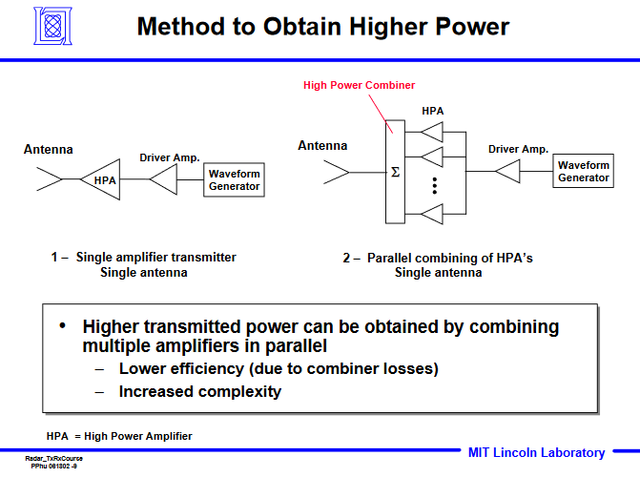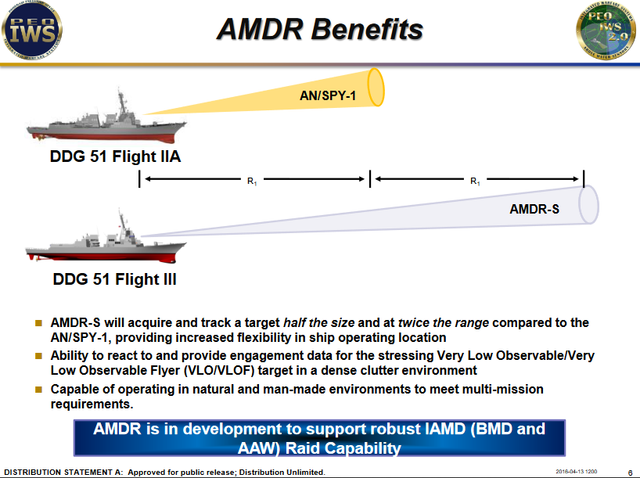CriticalThought
SENIOR MEMBER

- Joined
- Oct 10, 2016
- Messages
- 7,094
- Reaction score
- 13
- Country
- Location
@CriticalThought
While that was an informative read but people need to understand that terms such as PESA, AESA, GaA and GaN have 'marketing connotations' and actualized output level will vary from product to product in lieu with numerous design-related considerations beneath the surface (i.e. architecture complexity).
To give all a rough idea:


You see how the actualized output level of each product vary irrespective of the GaN and GaAs factor?
GaN is a leap from GaAs on several counts because of its netpositive impact on design-related considerations of applications (Size; Weight; Power; Cost) in theory but actualized output level of a product is to be taken at face value, and not theoretical considerations when drawing a comparison between products.
This statement: "This means, it will be able to handle larger electric power, which results in a longer range for the Block 3 radar as compared to Rafale's RBE2." - is a THEORETICAL consideration and not actually established.
KLJ-7A (AESA) is a major leap from earlier the earlier KLJ-7 (Pulse Doppler) radar system on many counts without any doubt and a welcome development for JF-17 Thunder platform (much thanks to China) - this is based on a rough comparison between officially disclosed actualized output levels of both products from NRIET (developer) as well as general difference between AESA and Pulse Doppler technologies even in theory.
However, a rough comparison between actualized output levels of NRIET KLJ-7A (AESA) and Thales RBE2-AA (AESA) should be considered for a fair understanding of this theme. This will be possible when JF-17 Thunder Block III will be inducted and more information about KLJ-7A (AESA) will hopefully surface.
NOTE: I am not asserting that Thales RBE2-AA (AESA) is one of the best AESA radar systems out there [on its own] - it is certainly not in the high-end spectrum of Western AESA products in existence. However, you simply declared RBE2-AA (AESA) obsolete based on GaAs factor? Dang...
The older RBE2 (PESA) can notice and track a target having a uniform RCS of 3m^2 around 111 KM mark (Notice-only range around 130 KM mark). The newer RBE2-AA (AESA) is claimed to offer over 50% leap in this parameter alone. RBE2-AA (AESA) also enable engagement of up to 8 targets in one go (impressive capability).
Some of the most powerful radar systems in service contain GaAs TRMs with certain design-related amendments which are not public knowledge and/or rather openly-taught knowledge (Architecture complexity beneath the surface). Blunt explanation(s) of superiority of GaN over GaAs in a Public source is not very telling [on its own].
GaN is certainly enabling emergence of more efficient and powerful products in hindsight - American AMDR and LRDR are two glaring examples - implied to be most advanced and powerful AESA radar systems in the world by far. However, sheer amount of research and resources poured into these projects is also phenomenal to say the least.
Above being said; combat aircraft are expected to receive cues from AWACS in potential airborne battles. It is therefore important to understand what kind of AWACS platforms IAF is inducting lately and which one is compatible with the emerging Rafale F3R fleet.
Your entire post is based on knowledge of Western capabilities and misunderstandings that arise from this limited view.
First, to establish the clear superiority of GaN, I quote from the link I posted in my post above
https://www.electronicdesign.com/te...ence-between-gaas-and-gan-rf-power-amplifiers
GaN’s high power density, or its ability to dissipate heat from a small package, makes it so impressive. While GaAs has a basic power density of about 1.5 W/mm, GaN has a power density ranging from 5 to 12 W/mm. It also has high electron mobility, meaning it can amplify signals well into the upper-gigahertz ranges. Typical transistor fTs are up to 200 GHz. Furthermore, GaN can do all this at relatively high breakdown voltages levels, up to 80 V or so.
The downside to GaN is its high cost. The materials are expensive, and the processes to make devices are costly. As volume increases, production costs will come down but will still remain way above the process costs of bulk CMOS or even higher-cost GaAs production.
The part numbers you quoted above were designed for a specific outcome and their performance parameters are a reflection of intended output. The correct way to look at this table is to note that these performance parameters are a reflection of current Western production processes which are behind current Chinese technology. This is why, as you put it, 'actualized output' doesn't seem very different between GaAs and GaN in Western chipsets. As I quoted in OP from Chinese source, these are the kinds of problems the Chinese were facing in 2018. In 2020, the West can only show its own impotence by banning Huawei based on unfounded fears. In research journals, Chinese researchers are reporting PAE levels of 64.7%-52.7%. Notice the 2020 in the quote below.
https://iopscience.iop.org/article/10.1088/1674-1056/ab821e/meta
High performance InAlN/GaN high electron mobility transistors for low voltage applications*
Minhan Mi (宓珉瀚)1, Meng Zhang (张濛)1, Sheng Wu (武盛)1, Ling Yang (杨凌)2, Bin Hou (侯斌)1, Yuwei Zhou (周雨威)2, Lixin Guo (郭立新)3, Xiaohua Ma (马晓华)1 and Yue Hao (郝跃)1
© 2020 Chinese Physical Society and IOP Publishing Ltd
A high performance InAlN/GaN high electron mobility transistor (HEMT) at low voltage operation (6–10 V drain voltage) has been fabricated. An 8 nm InAlN barrier layer is adopted to generate large 2DEG density thus to reduce sheet resistance. Highly scaled lateral dimension (1.2 μm source–drain spacing) is to reduce access resistance. Both low sheet resistance of the InAlN/GaN structure and scaled lateral dimension contribute to an high extrinsic transconductance of 550 mS/mm and a large drain current of 2.3 A/mm with low on-resistance (R on) of 0.9 Ω⋅mm. Small signal measurement shows an f T/f max of 131 GHz/196 GHz. Large signal measurement shows that the InAlN/GaN HEMT can yield 64.7%–52.7% (V ds = 6–10 V) power added efficiency (PAE) associated with 1.6–2.4 W/mm output power density at 8 GHz. These results demonstrate that GaN-based HEMTs not only have advantages in the existing high voltage power and high frequency rf field, but also are attractive for low voltage mobile compatible rf applications.
The rest of your post is just an attempt at presenting a 'balanced' world view. And this is the problem with Americans - they don't have the graciousness to accept defeat once they have appointed someone their arch enemy. That's a problem you need to solve in your own mind.
@Beast @LKJ86 guys could you tag Chinese posters who can give us insight into current Chinese accomplishments in the field of GaN based RF power? My access is limited to the English language web, but you guys can search Chinese sites as well. Your input will be most appreciated.









